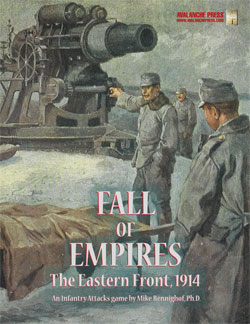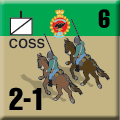| Fall of Empires:
Scenario Preview, Part Three
By Mike Bennighof, Ph.D.
November 2023
 Over the many years that Infantry Attacks: Fall of Empires remained in the design stage, I designed a lot of scenarios for it. Most of them I set aside as I came up with new ones, or better ways to show the battles I’d already selected. They weren’t telling the story the way I wanted. Over the many years that Infantry Attacks: Fall of Empires remained in the design stage, I designed a lot of scenarios for it. Most of them I set aside as I came up with new ones, or better ways to show the battles I’d already selected. They weren’t telling the story the way I wanted.
Then we hit on the story arc format, with the scenarios linked together in chapters and tied up with battle games, and it fell into place. Sketching out the progress of the battle first, and then putting together scenarios to drive that narrative, makes things fit together much more smoothly, at least in my own mind.
That makes Fall of Empires a more idiosyncratic work than most of our games; its scenario set reflects the campaign history as I envision it. The game format allowed me to show that in a way that a book would not have. I’m pretty pleased with it, so let’s look at another chapter.
Chapter Three
The Battle of Kraśnik, Day Two
More than half of the Russian Fourth and Austrian First Armies had seen no action on the battle’s first day. That would change on the second, as every corps on the battlefield crashed into its opposite number and intensive fighting erupted along forty-kilometer front. Each side had hopes of turning the enemy’s flank, but the Austrians had superior numbers and their commander, Viktor Dankl, was determined to make use of his advantage while he had it. More Russian divisions could arrive any day now, but there would be no more Austrians beyond the raw, untrained Landsturm brigades.
Scenario Ten
The Failed Grenadiers
24 August 1914
 After the Austrian successes on the 23rd, the Russian South-West Front command ordered its Fourth Army to hold its positions while its neighbor to the east, Fifth Army, marched to roll up the Austrian First Army’s right flank. The Grenadier Corps, on Fourth Army’s left wing, continued moving directly southward where it crashed into the Austrian X Corps awaiting them along a shallow stream known as the Biala Lada near the village of Goraj. After the Austrian successes on the 23rd, the Russian South-West Front command ordered its Fourth Army to hold its positions while its neighbor to the east, Fifth Army, marched to roll up the Austrian First Army’s right flank. The Grenadier Corps, on Fourth Army’s left wing, continued moving directly southward where it crashed into the Austrian X Corps awaiting them along a shallow stream known as the Biala Lada near the village of Goraj.
Conclusion
The Polish-Ukrainian troops met the Grenadiers - regular infantry regiments raised in Moscow that carried the old honorific - along the river line and held firm. And then, of course, they attacked. The Russians made repeated attempts to get across the Biala Lada, all of which failed, but as happened elsewhere during the battle the Austro-Hungarian division racked up needless additional casualties by attacking despite having achieved their own defense objectives.
Notes
In any other Infantry Attacks or Panzer Grenadier game, this would have been a river-defense scenario. But not when the Austrians of 1914 are involved; it’s not enough for them to keep the Russians from crossing to their side of the river. If they want to win, they’re going to have to cross over themselves and attack the Grenadiers. Operationally, the 24th Infantry Division does its job just by holding here, but that’s not the mindset of the Habsburg forces.
Scenario Eleven
Foot Cavalry
24 August 1914
 The Russian cavalry attached to the advancing XVI and Grenadier Corps failed to detected the Austro-Hungarian X Corps in front of them, and the infantry columns blundered into the enemy and sharp fighting soon developed. Purely by accident than by any design, the Russian Grenadiers found the gap between the Austrian 2nd and 24th Infantry Divisions, formed when both Austrian units responded to the appearance of Russians on their front by attacking them. Feldmarschall-Leutnant Leopold Freiherr von Hauer’s cavalry division had been tasked with screening and reconnaissance, but when the Grenadiers attacked Hauer promptly ordered his troopers to dismount and stop them in infantry combat. The Russian cavalry attached to the advancing XVI and Grenadier Corps failed to detected the Austro-Hungarian X Corps in front of them, and the infantry columns blundered into the enemy and sharp fighting soon developed. Purely by accident than by any design, the Russian Grenadiers found the gap between the Austrian 2nd and 24th Infantry Divisions, formed when both Austrian units responded to the appearance of Russians on their front by attacking them. Feldmarschall-Leutnant Leopold Freiherr von Hauer’s cavalry division had been tasked with screening and reconnaissance, but when the Grenadiers attacked Hauer promptly ordered his troopers to dismount and stop them in infantry combat.
Conclusion
The cavalry did something the Austrian infantry would not - dug themselves in to hold their ground and block the Russian advance. By holding the Grenadiers, the cavalry not only protected the inner flanks of the two neighboring infantry divisions but pinned their Russian opponents to allow a Landwehr infantry division to turn the Grenadier Corps’ left flank.
Notes
This time the Austrians are holding their line with a dismounted cavalry division, which unlike the infantry is able to dig in and hold its ground - one of the stranger quirks of the Imperial and Royal Army of 1914 is that its cavalry actually had more realistic doctrine for dismounted fighting than the infantry. The problem was getting its commanders to dismount at all. When they did, as in this case, they still suffered from a distinct lack of firepower.
Scenario Twelve
Spirited Counter-Attacks
24 August 1914
 To the west of the Grenadier Corps, the Russian XVI Corps also moved directly southward instead of turning to the west as army commander Anton von Salza apparently had intended. They encountered the left wing of the Austrian X Corps, the Anton Liposcak’s 2nd Infantry Division. Liposcak, a well-regarded officer whose career had suffered from his poor health, had his troops ready when the Russians appeared and promptly attacked them. To the west of the Grenadier Corps, the Russian XVI Corps also moved directly southward instead of turning to the west as army commander Anton von Salza apparently had intended. They encountered the left wing of the Austrian X Corps, the Anton Liposcak’s 2nd Infantry Division. Liposcak, a well-regarded officer whose career had suffered from his poor health, had his troops ready when the Russians appeared and promptly attacked them.
Conclusion
With what the Austro-Hungarian official history would call “spirited counter-attacks,” Liposcak’s troops threw the Russians back and blunted their advance. As elsewhere along First Army’s front, the Polish and Ukrainian battalions suffered terrible losses in achieving their victory, particularly among their officers. Second Infantry Division would not be able to repeat this feat many more times.
Note
This scenario is a free-for-all meeting engagement, one that encourages both sides to come forward and attack. It is one of the few where the Austrian actually face a penalty for incurring casualties, though they can overcome that by inflicting more of them on the Russians (which is what they actually did in this battle).
Scenario Thirteen
The General
24 August 1914
 Ordered to take the village of Suchodoly, Maj. Gen. Richard Kutschera mounted his horse and drew his pallasch. A Viennese, Kutschera entered the Army at age 16 as an engineer cadet, rising to general despite the lack of an Academy pedigree. He’d commanded his brigade since April 1911, spoke his men’s languages and knew most of them by name. Polacy naprzod! (Poles forward!) he shouted to the Polish infantrymen of the 13th Infantry Regiment. Behind their general, the Krakow-recruited battalions surged toward the Russians at a run. Ordered to take the village of Suchodoly, Maj. Gen. Richard Kutschera mounted his horse and drew his pallasch. A Viennese, Kutschera entered the Army at age 16 as an engineer cadet, rising to general despite the lack of an Academy pedigree. He’d commanded his brigade since April 1911, spoke his men’s languages and knew most of them by name. Polacy naprzod! (Poles forward!) he shouted to the Polish infantrymen of the 13th Infantry Regiment. Behind their general, the Krakow-recruited battalions surged toward the Russians at a run.
Conclusion
Kutschera, the only man on horseback in the Austrian ranks, would be the first man killed in his brigade’s attack. Despite a complete lack of artillery support, even field guns, his brigade continued their advance despite the loss of their general and many other officers. Soon they had taken all of Suchodoly at the cost of over 350 casualties. Once again, the Austro-Hungarian army had won a victory it could not possibly sustain. Multi-lingual, highly-trained and dedicated career officers like Kutschera would be replaced, at least in the lower ranks, by products of the one-year volunteer reserve officer training program.
Notes
There’s a book out there that cites this action as yet another example of the congenital stupidity of all Austrians. Once you get past that guy’s troubling ethnic hatred, what it reveals is the story of the Empire’s fall in microcosm.
Aftermath
 The second day of combat at Kraśnik saw Austrian success all along the front as the pushed the Russians around and inflicted heavy casualties on them, but at an enormous cost to their own side. While Anton von Salza’s Fourth Army remained on the battlefield, it had been shaken and Dankl believed that he could turn the Russian flank on the next day and break them, inflicting a major defeat. The second day of combat at Kraśnik saw Austrian success all along the front as the pushed the Russians around and inflicted heavy casualties on them, but at an enormous cost to their own side. While Anton von Salza’s Fourth Army remained on the battlefield, it had been shaken and Dankl believed that he could turn the Russian flank on the next day and break them, inflicting a major defeat.
There would be no actual third day of combat, though the Austrian high command celebrated their three-day victory. The Austrian dawn attack did not jump off until 1000, by which time the Russians had successfully broken contact to retreat toward Lublin. Austria-Hungary had won the first great battle of the Great War, at a horrifying cost in lives. Viktor Dankl would eventually receive the Military Order of Maria Theresa with the attendant instant ennoblement, choosing “von Kraśnik” as his noble predicate.
And that’s Chapter Three.
You can order Fall of Empires right here.
Gold Club members can score an extra 20 percent off.
Infantry Attacks Package
August 1914
Fall of Empires
Franz Josef’s Armies
Winter’s Battle
Retail Price: $212.96
Package Price: $170
Gold Club Price: $136
You can experience the Infantry Attacks Package right here.
Sign up for our newsletter right here. Your info will never be sold or transferred; we'll just use it to update you on new games and new offers.
Mike Bennighof is president of Avalanche Press and holds a doctorate in history from Emory University. A Fulbright Scholar and NASA Journalist in Space finalist, he has published a great many books, games and articles on historical subjects; people are saying that some of them are actually good.
He lives in Birmingham, Alabama with his wife and three children. He misses his Iron Dog, Leopold. Leopold enjoyed gnawing his deer antler and editing Wikipedia pages.
Want to keep Daily Content free of third-party ads? You can send us some love (and cash) through this link right here.
|
